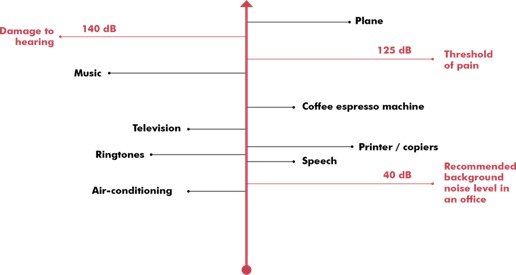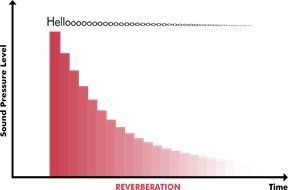Request A Call Back
We will get back to you as soon as possible
Please try again later
How to soundproof your home - DIY Soundproofing
How to soundproof your home, DIY Soundproofing.
We may as well face up to the fact that unless you live in a remote part of the countryside in a house with immensely thick walls, then noise pollution is a part of our everyday life. Loud music, noisy neighbours and loud televisions, not forgetting high levels of road traffic noise. These are just some of the typical noise pollutants which regularly invade our homes when we are trying to relax after a stressful day.
It’s a real thing, and a total invasion of our privacy but there’s not a lot that you can do about it. Right?.......
Wrong. Before you decide to move away from the constant din surrounding you, read our straightforward guide to soundproofing your home. From your windows to your walls, your ceilings to your doors, our guide will ensure you will not hear as much as a murmur from outside. And if you are on a tight budget, we have tons of helpful tips which will reduce noise in any property and without too many complaints from your wallet!
Why should I consider soundproofing my property?
As well as noise being an irritant, UK environmental consultants believe that excessive levels of noise pollution can actually harm your health. Alarming hey, well we can help!
The Government also shows concern about the problem of noise pollution and has passed a legislation for all new buildings and refurbishments known as Building Regulations Part E OR “Resistance to the Passage of Sound”. The sole aim of these regulations is to improve sound insulation, not only between dwellings but within the properties themselves and also between shared property such as rooms in hotels, hostels, and residential buildings.
How does sound travel from A to B or even C, D and E?
Well, in order to best soundproof your home, it is important to understand a little bit about how sound works. Sound is made up of low frequency waves, look at them as vibrations. When something makes a sound, it emits these waves which then travel in all directions from the source.
These waves or vibrations will keep travelling until they meet some form of resistance, such as a wall or sofa, floor or ceiling. However, they can also bounce off these items and that causes an effect known as reverberation, commonly known as ‘Echo’ which then annoyingly strengthens the sound. It’s important to utilise efficient soundproofing materials that not only absorb and block sound, but also control the amount of reverberation or echo. This keeps things nice and quiet!
How does soundproofing actually work?
In laymen’s terms, the only way to stop sound is to either ‘reduce it’ or ‘absorb it’. Whether you opt to go down the DIY route or use a professional, the method should always utilise one or both of these techniques.
The first technique is sound reduction. Noise reduction or attenuation works by blocking the passage of sound waves OR vibrations with the use of decoupling heavy mass composite materials that intervene in the passage of sound. These materials are known as soundproofing composite materials or acoustic isolation systems.
The second technique is sound absorption, this control of reverberation or echo. This operates by transforming the sound wave itself. While this might sound like a dark art, it simply means that the wave changes when it comes into contact with certain materials. Obvious examples would be to introduce carpets and soft furnishings however this isn’t always enough. The introduction of specifically designed acoustic sound absorbing materials will often solve this issue.
When sound hits a surface it automatically turns to heat in turn creating vibrations, with materials designed specifically for controlling noise, these vibrations are absorbed and blocked. This is because the wave transfer through different layers of material with different densities all have a part to play assisting in noise damping.
But a word of warning – It’s a common misconception that ‘egg box profile foam’ or any kind of foam will soundproof your wall or ceiling, these only absorb reflective noise to a degree however still allow sound to pass straight through them. To block sound, you need ‘mass’ for example a gypsum composite board and the decoupling or separation of the internal surface to the main building structure with the use of isolation clips and furring channels. This will give you what you need to block out that ‘noisy neighbour’.
Is it possible to soundproof my home myself?
It is completely possible to soundproof your home yourself, although the key is to get the correct products for your particular needs. At acuphon we provide sound proofing solutions and materials that need only low to moderate DIY skills.
Whichever route you choose, it’s probably worth considering that if you intend to spend a lot of money on sound proofing your home and you possess only basic DIY skills, then it might be more cost effective to get the professionals in. Most builders nowadays are familiar with building regulations and Part E. It would be very frustrating and costly to do the work and then have to cover your ears again!
What a din!
The first step when sound proofing your property is to work out where the sound is coming from and what part of your home most needs sound insulation. The problem with sound is that it will find every crack in your home in which to sneak in, much like rainwater finding a drain hole, so a thorough examination of walls, doors and windows is in order.
A good way to do this is to turn everything off in your home and listen carefully to where unwanted sound is emanating. It may be worth trying this at different times of the day when there will be different levels of noise in your surrounding neighbourhood. In order to soundproof your home most efficiently, you will need an idea of the level of noise you are attempting to block out.
Sound is measured in decibels (dB) and the chart below will give you an idea of what levels of sound you are dealing with. This vital information will determine what type of materials you need for your particular property.
Common sounds measured in decibels (dB)
| Type of Noise | Audibility (in dB) |
|---|---|
| Rustle of leaves | 0 dB |
| Quiet conversation | 30 dB |
| Ambience in a city at night | 45 dB |
| Background noise in an office | 50 dB |
| Average radio | 60 dB |
| Car passing on the street | 70 dB |
| Intercity train/loud music indoors | 80 dB |
| Pneumatic drill at 3 metres | 90 dB |
| Jet plane taking off at 100 metres/Rock band | 100 dB |
| Screaming baby/Industry legal limit | 115 dB |
| Deafening | 120 dB |
Materials used for sound proofing rooms are all rated for their effectiveness at dampening sound. The ratings for impact sound are commonly known Ln and L'nT,w (dB) ratings. Basically the higher the rating, the better the sound proofing capabilities of a material. Whereas for Airborne Sound Insulation this is expressed by a single values, for example DnT,w and Rw
Many modern window systems, insulation and carpeting all come with acoustic ratings, even if they are not specifically for sound insulation. Specialised sound proofing materials will not only have these impact and airborne ratings but have additional qualities that are specially designed to deal with all levels of noise pollution.
Where are my problem areas likely to be?
What a pain!
Windows tend to be the biggest culprit for sound entering or leaving your home, with single glass panes often the worst offender of all. There is some irony here, with single glass panes usually found on older properties, which in many cases have a very thick wall construction, then replacing the window units to double glazing OR by adding secondary glazing, then the difference would be immense. If you live on a noisy street upgrading to double glazing will be a godsend. The added thickness works wonders at noise reduction, helping to block out the sound of traffic and roadworks from outside.
How swish!
Although highly effective, if buying new windows sounds too expensive, then the next best thing can be to buy heavy curtains or drapes. There are special kinds of drapes known as sound deadening drapes and they come in a variety of styles to suit your tastes, compared to new windows, they shouldn’t break the bank.
Plug it!
Window plugs are simply soundproofing mats that are cut to the exact size of your window frame. The plugs are normally one or two inches thick and are easy to fashion yourself.
Window plugs form a tight sound barrier around the cracks in the window frame but they will also block the light, so are only really suitable for use at night time.
Our Walls Have Ears!
Despite appearances, the walls in a room can be the least solid barrier for noise. Standard thin drywall can be ineffective for hampering travelling noise, but there are solutions!
Adding a gypsum composite board……
Budget option - simply adding more mass to a wall can improve sound resistance. The basic rule of thumb is the heavier the product, the better.
Golden options - again by adding more mass but this time hang the gypsum composite from isolation clips and furring channel system, this time, totally de-coupling the internal surface from the main buildings structure OR if you’re pushed for space a direct fix approach would be better, then our 30mm thick system works with outstanding performance.
Insulation……
Adding insulation to your walls can help improve sound absorption. This is especially handy if you are moving into a newly built home as you can apply mineral fibre insulation to the walls before both sides of drywall have been put up.
The rule of thumb here is, the thicker the insulation, the better sound absorption you will have. Don't worry if your walls have already been built, you can still apply insulation by cutting holes in the drywall between the wall studs. You then blow in foam or paper insulation, which will dampen sound.
Wall coverings for sound absorption……
If you are renting your property, or you simply don’t want to go inside your walls, then you can apply wall covering material with sound absorption properties on the outside of your walls, surface mounted. These materials are generally either fabric upholstered to match furnishings OR you can opt for the acoustic aRTpanel OR designer panel, these will then look like any other artwork you have in the house but with one difference, these absorb sound!
Look up!
Well, this time, before you look up, look down! If you can soundproof the floor above your ceiling then this is a far easier option, you can do this with soundproof underlay OR acoustic underlay as it’s best known. Soundproofing the ceiling is far trickier because it involves either ripping out the existing ceiling OR installing a false ceiling, either way it’s as difficult and potentially as messy as it sounds. The potential false ceiling needs to be attached to resilient bars that create a cavity between the existing ceiling and new one. Without this cavity you won't benefit from a reduction in sound. This option you do lose ceiling height in your room however, if you have space then no matter! Again, you may need the professionals in to do this work for you. You see, treating the above floor now sound like a good option?
Cover the Upstairs Floors
Adding a good carpet or soundproof underlay OR acoustic underlay first prior to the carpet is an excellent solution for impact and airborne noise between floor levels, by adding these products to an upstairs room, you can drastically reduce the level of noise heard below and vice versa.
Insulate the Ceiling
Depending on your level of DIY skills, you can remove the drywall on your ceiling, and insert layers of mineral fibre insulation, 45Kg/m³ should do it, friction fit between each joist. While you’re up there you may as well go the whole hog and install the ceiling on isolation clips and channels , this system is second to none and fantastic at stopping sound travelling through. Not afraid of losing ceiling height then go for the dropped ceiling option , this is less messy!
Close the door please!
It might ‘sound’ obvious but why spend hundreds of pounds for top soundproofing products to then ruin it by leaving your doors open? Serious note though, don't forget that snug fitting internal and external doors in your property are vital for trapping sound, otherwise your sound insulation efforts are to be wasted, if on a budget then retrofit acoustic door seals can help solve these problems!
If you can afford it, then solid wood acoustic door sets make excellent sound blockers, at the same time making sure you have airtight thresholds, door heads and jambs. This type of door system makes a world of difference!
Are there any quick fix solutions?
If you’re on a tight budget, then don’t worry. Here we have compiled a list of some of the cost-effective ways of reducing sound that are guaranteed to be ‘music’ to your ears! OR not, as this case may be, re-phrased to bring ‘silence’ to your ears!
- Try to ensure that at least 25% of every room contains absorbent materials, such as quality carpeting, furniture, or heavy curtains. These materials will help dampen omni-directional sound waves and absorb sound.
- If you’re really stuck then you can always hang carpeting or bedding or push mattresses up against the walls, to help reduce sound transmission. Doesn’t look great and not overly effective but will offer some respite.
- You can attack noise at the source. Place composite matting or pieces of rubber directly under the legs or corners of heavy appliances, for example a washing machine or fridge freezer. This reduces vibration and low frequency noise humming through the floors.
- Put stereo speakers on isolation stands to prevent turning floors and walls into whole-house speakers.
- Mask noise in your garden space or small courtyard with table-top fountains, garden water features, or plant ornamental grasses that make a soothing sound when the wind blows, these create a pleasant background noise that helps create speech privacy.
- Place weather stripping around all doors, even interior ones. Replace any weather seals that are loose admitting light or air. Seal it equals sound isolation in loose terms!
The Sound of Silence!
Your home has turned into an oasis of silence and is now a den of tranquillity. Just by reducing or absorbing unwanted sounds, whether you have a go yourself or use a professional, the costs need not be excessive and the rewards speak for themselves.

SOUNDPROOFING
ABSORPTION
CONTACT US
Monday - Friday
7:30am - 5:00pm
Saturday - Sunday
Closed
Contact Methods
Phone: +44 (0)1904 900 194
General: support@acuphon.co.uk
Finance: accounts@acuphon.co.uk
Provider of soundproofing and sound absorption products. Nottinghamshire, Great Britain.
Delivered and Installed UK wide.
© 2024 Acuphon Ltd







